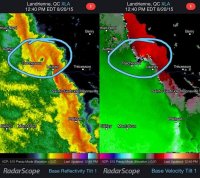Not sure exactly what question you're asking, but...
IMO, the term "mesovortex" is ambiguous. There are tornadoes that spawn from semi-mesocyclonic processes in QLCSs (what some call QLCS tornadoes), and then there are bookend vortices.
Regarding the first type: you can get spin ups, pretty much exclusively along the front edge of an advancing (usually progressive) squall line. These types of tornadoes are typically weaker than mesocyclonic tornadoes spawned in supercells, but there have been a number of cases of EF2 and even EF3 tornadoes spawned in this manner. They typically form quickly and don't live long and are thus difficult to forecast. However, they generally exist on the same scale as mesocyclonic tornadoes typical of supercells. You'll generally see either an inflow notch dig into the precip, or a hook echo develop and extend into the clear air ahead of the convective portion of the squall line. When that happens, that's generally an indication of a mesocyclone that has developed along the front edge of the squall line. Again, they typically aren't long lived or very big, but they can and do produce tornadoes.
The second type of vortices form along the flanks of mesoscale convective systems/squall lines. They are related to what
@Kendra Sand described as being formed from horizontal wind shear, usually the difference between rear inflow near the apex of a bowing segment of the squall line and the ambient storm relative flow just off to the side of the convective portion of the squall line. Such vortices are much larger in scale than tornadoes or mesocyclones (10 to 100 times larger), and have weaker vorticity. Bookend vortices have spawned tornadoes before, and there is some relationship between the relative position of the bookend vortex to the rest of the squall line and the tornado likelihood, but such tornadoes are pretty uncommon and usually very weak.
Regarding the angular momentum conversation part...yes, conservation of angular momentum is likely a significant contributor to ALL tornadogenesis events. I don't think there's anything special about it for QLCS tornadoes or bookend tornadoes.


